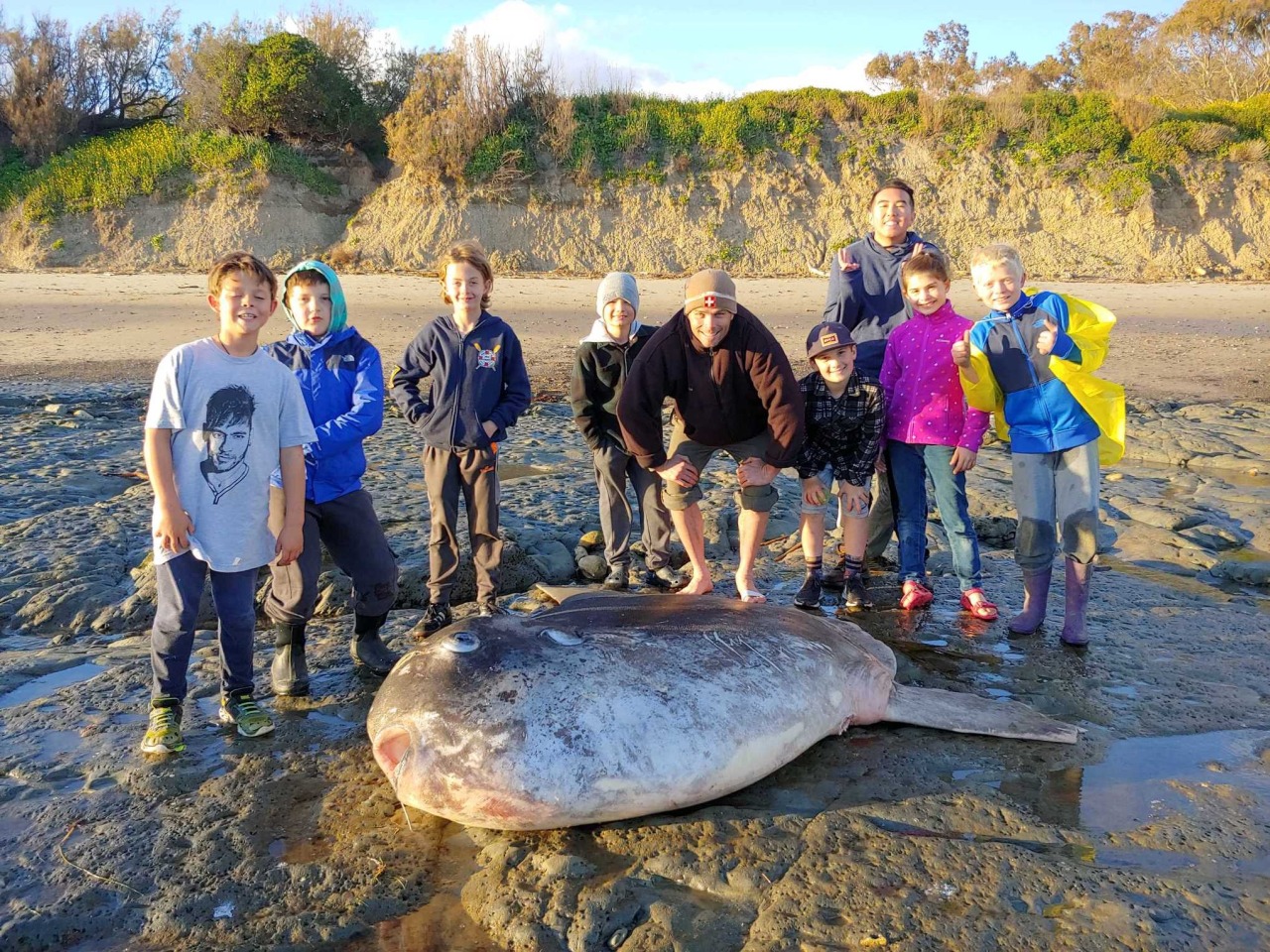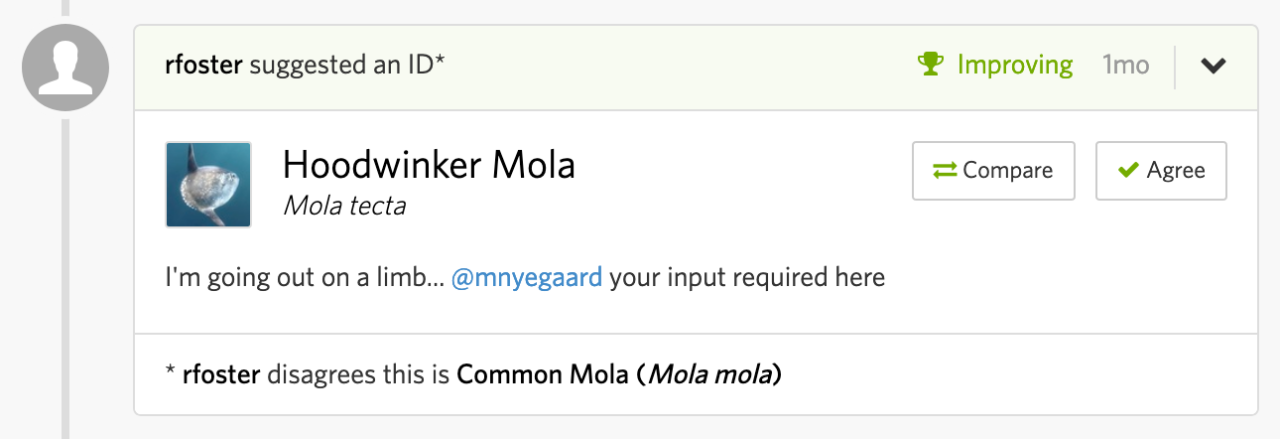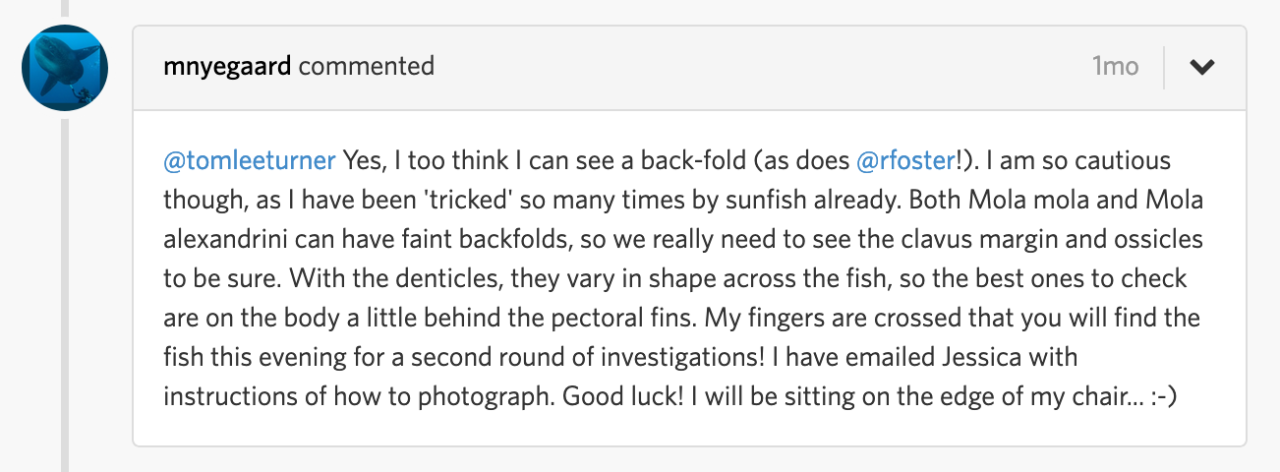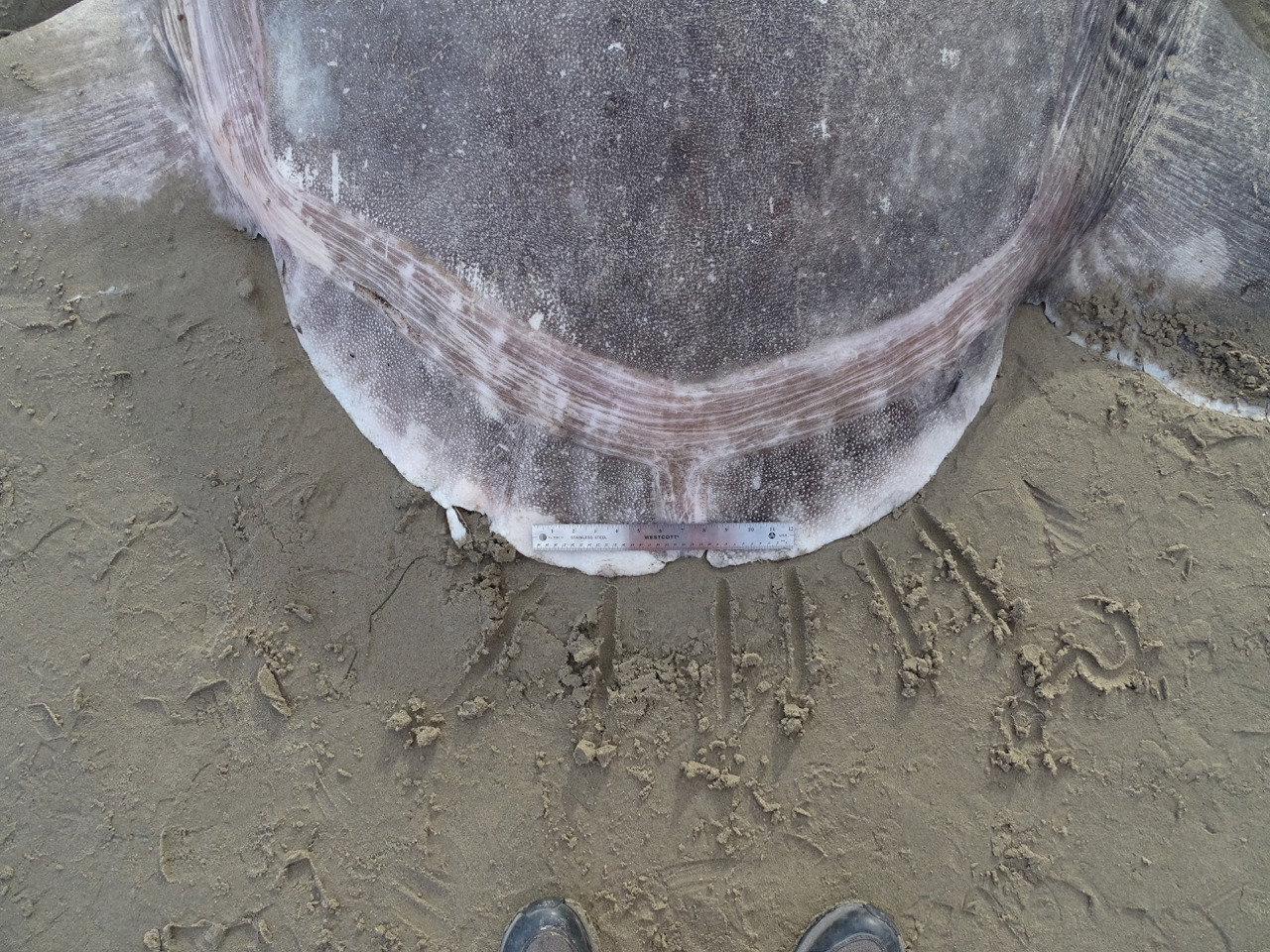Holy Mola! - The Oral History of an iNat Identification
The iNaturalist community made international headlines a few weeks ago after the first hoodwinker sunfish (Mola tecta) seen in North America was shared and then identified via iNaturalist and some dedicated participants. It really is a great story that shows the power of collaboration and the importance of keeping an open (and optimistic!) mind, so I thought it would be fun to compile an oral (although in this case, written) history from the participants.
What follows are the lightly edited and condensed recollections of most of the people involved, put together as chronologically as possible. I have not heard back from all participants, but am happy to add your input if you message me.
Jessica Nielsen (Coal Oil Point Reserve): My first observation of the hoodwinker sunfish was on the morning of February 19th, 2019. A colleague, Mark Holmgren, and I were conducting the reserve's monthly bird monitoring survey at around 7:00 am and noticed a tall dorsal fin flopping about in the water about a hundred meters off of the point at Coal Oil Point Reserve. We weren't sure at the time what animal we were looking at as we couldn't see it very clearly in the water, but we assumed it was some kind of marine mammal based on the size of the fin and head. Later the same day, when a 7 foot long sunfish washed up on the beach, we realized that was what we had seen that morning.
I was alerted to the washed up fish by one of our UCSB student interns, Ruth Alcantara... Unfortunately, the fish was already dead but it was still a sight to see such a large and unusual fish up close. I took some measurements and photos and posted the finding to Coal Oil Point Reserve’s Facebook page.

Daniel Spach (Wilderness Youth Project): We were about to leave Devereux that day after tidepooling for a couple hours when a couple of the kids spotted what looked like a dead seal or something in an unusual posture near the beach on the rocks. When we got over there we were stunned to find something I had never seen or heard of anyone finding on a Santa Barbara beach... a Sun Fish? It was longer than I am tall, over 7 feet I'd say, super flat and roundish, with a mouth big enough to swallow my head. All the kids gathered round and were giddily excited about it, noting the shape of the fins and eyes, making guesses as to its watery demise. Everyone seemed a bit scared to touch it though, thinking it would be slimy like most decomposing fish we'd encountered but its skin was actually extremely hard, dense, and rough, like an ocean rhino or something.
Kittyhawk snapped a few pictures [TI: see above] with her phone. The kids all wanted to make sure their parents would get a copy of the pictures. Might be the only time any of us will encounter this fish for our lifetimes.
Jeff Phillips (@ljefe): My 10-year old son Pierce participates in the Wilderness Youth Project’s after school program every Wednesday. [On] Feb 22, when I met the group to pick up my son and friends at 5:30pm, they were excited about this huge fish they had found on the beach during their afternoon outing (sometime between 2 and 4:30pm). I’m a biologist with the U.S. Fish and Wildlife Service so they knew I’d be excited about it. I had them send me the photo and with my son’s help to mark the location, I posted it on iNaturalist, originally identifying it as Mola mola. I thoroughly enjoyed the ensuing discussion among tomleeturner, rfoster, and mnyegaard.
Tom Turner (@tomleeturner): I saw [Jessica’s] post and went down there with my family, because I wanted my 4 year old son to check it out. I posted it on iNat, of course, because…that is what I do. Everyone was assuming it is a Mola mola. What happened next is a classic example of iNat at its best.
Ralph Foster (@rfoster): I have an alert for Mola spp and was checking through the day's offerings when I saw what I took to be a stranded Mola tecta. I was bewildered when I realised this was in California and not in New Zealand or Australia so I tagged Marianne [Nyegaard, who described Mola tecta], asking for her input.

Marianne Nyegaard (@mnyegaard): Ralph Foster emailed me with links to iNaturalist asking if I could see what species it was, strongly suspecting it was Mola tecta. I quickly checked and thought that the fish surely looked like a hoodwinker, but frustratingly, none of the many photos showed the clavus [TI: aka what sunfishes’ back “fin” is called] clearly. And with a fish so far out of range, I was extremely reluctant to call it a hoodwinker without clear and unambiguous evidence of its identity... I emailed Ralph and told him we needed more photographs and ideally a tissue sample, and posted on iNaturalist that his was probably just a Mola mola.
Ralph Foster: Since there were no diagnostic features shown, I also tagged the observer (@sealovelife) asking if there were more images available, which is when Tom directed me to his observation.

Tom Turner: By this time I was already out on the beach in the dark looking for the fish to get better photos, because what could be more fun than this? Alas, the tide had floated it away again.
Marianne Nyegaard: I then had a cup of coffee and doubt starting creeping in... I spent the next few hours obsessively zooming in on all the photos posted on iNaturalist... Some photos showed peoples’ hands on the sunfish, so I used their fingernails to gauge the scale and compared the skin with my archive photos. Even though the resolution just wasn't high enough to be sure, I started convincing myself the skin at least wasn't incompatible with Mola tecta and that ….perhaps it was a hoodwinker?... But I felt I needed to be absolutely 100% sure before settling on an ID, seeing I had described the hoodwinker and would need to back up my ID with absolute certainty with a specimen so far away from home.
I woke up to an email from Jessica Nielsen saying [she and Tom] were keen to go back out and find the fish again so I sent them instructions of what to look for and photograph, and then sat on the edge of my chair with all fingers and toes crossed that they would find it.

Tom Turner: At low tide (now two days later), I started biking on the beach from the east, and Jessica started walking from the west, 2 miles apart. We met in the middle, at the fish, now a few hundred yards farther east.
Jessica Nielsen: Tom and I waited for the tide to go out, found the fish...and we got to work taking the photos and fin clips requested. It really was exciting to collect the photos and samples knowing that it could potentially be such an extraordinary sighting! Once we sent over the photos, Marianne responded very quickly.

Marianne Nyegaard: I was away from my desk most of the day, but when I checked my emails in the afternoon I literally nearly fell off my chair (which I was sitting on the edge of!). Tom and Jessica had indeed found the fish and had photographed and examined it, and taken a tissue sample. A huge amount of extremely clear photos were in my inbox and there was just no doubt of the ID. They had also examined the clavus by hand to confirm the number of ossicles, which was just brilliant. Eyes and ears and hands on the ground half a world away, wow.

Ralph Foster: If it hadn't been for Tom and Jessica's willingness to revisit and examine the specimen we would not have known with certainty that this was, indeed, Mola tecta.
Jessica Nielsen: We were all thrilled to hear the news. Mola tecta was just recently discovered in 2017 (by Marianne and her research team) so there is still so much to learn about this species. I’m so glad that we could help these researchers make the final definitive ID.
Tom Turner: iNaturalist at its best: experienced novice loops in expert who loops in the expert who then helps us learn about our find and gets info she will use in her research. And it was fun and exciting for all.
Marianne Nyegaard: Ralph Foster also alerted the University of California, who did a beach dissection and collected a large number of samples. Tissue samples will soon be on the way from California to my sister’s lab in Denmark, where I do all my sunfish genetics.
So, within 24 hours after I had first been made aware of this stranding we had confirmed the ID. I just love iNaturalist and am continuously amazed by how much fun it is to “meet” passionate people all over the world




Comments
That's amazing! I have been trying to learn more about the biota of a new Natural Area where I work. Already iNaturalists have discovered a fungus on site not previously known from Vermont and the species list grows regularly as people add their observations. None of it is incredible as this amazing story, but it is wonderful to be a scientist plugged into this world of willing collaborators.
I'm glad to see the fish was not washed out to sea! Stroke of luck; and of course hard work. Fortune favors the bold! Continue in your bold efforts to learn about our fellow travelers.
Ah, what a superb story! INat at its best -- how lovely is that!
so neat
And the (next) coolest thing is that stories of collaboration like this play out in relative obscurity all over iNaturalist every day!
This is such an awesome story!
neat-o! I love recapitulating iNat identification strings. This is a particularly awesome one, though, to be sure!
What a discovery!
It's amazing as people in different part of the world were working together to get this identified!! Thank you @tiwane for sharing the story too.
What a great story! I bet the kids were so excited and to have a photo shared with iNaturalist. With such an awesome find! Thanks to everyone who helped get this to this site to share with all of us.
Fantastic story & incredible discovery
What a fabulous story! The power of community and technology come together so beautifully in iNaturalist. What a fabulous tool and platform!
Cool story!
Wow! How I wish to see a Mola...
Oh wow! This literally brought me to gentle tears. How magnificent that kids participated in such a moment - that's the stuff of which lifelong life-lovers are made. And what a wonderful and respectfully collaborating community we form, that we can value the contributions of anyone who takes the time to learn and share.
And I first saw this story on BBC :-)
It is something credible! Congratulations to this group of young people who represent the future of the planet and my congratulations to the entire iNaturalist community for the excellent work that is done on a global level.
Excellent story!
What an absolutely amazing story on so many levels. Congrats to everyone involved for their work here and for sharing this with the broader community. iNaturalist has the potential to do so much good and transcend so many previously entrenched barriers to scientific research. This is likely just the beginning. I'm feeling pretty privileged to be a member of this community (even if I never find anything this cool to share with y'all!).
Really cool story!
This is a wonderful story.
Just brilliant!!
So awesome!! Go iNat!
THIS! This is why I tell everyone to get on iNat. Such a powerful tool and a fantastic community.
iNat at its best!!
@jdmore I agree. This kind of thing happens all the time on iNat on a less public scale. If i have a problem identifying a moth, or just want a second opinion, I can call on people all over the world. It's a fantastic way to share the expertise we all have, and to expand that through learning (ie respectful feedback).
Ian
BTW, I know that this is a biology site, but I would love to get a Geologists take on the sand cliff face in that first photo!!
Ian
@mamestraconfigurata I totally agree!
rockd.org is probably the closest geological analog to iNat.
@tiwane thanks! I didn't know about that site. What a great resource for the amateur in the field. And since, at least in the western US, esp south, geology and botany are so tightly connected (and visible) it will be excellent on my upcoming desert trip :-)
@tiwane Thanks for that. Geology is also one of my fascinations!
Another really awesome write-up, Tony.
This too has been one of my favorite stories of the year! :)
Just following up here after reading the really nice USA Today article from this past February.
Looks like there have been five new observations of Mola tecta in California uploaded to iNat since the Santa Barbara find! No other observations in the northern hemisphere, though.
Reinforcing the value of iNaturalist's real time data sharing. Fantastic!
Another article about Mola tecta on the west coast of North America, this time in British Columbia: https://www.cbc.ca/news/technology/meet-the-hoodwinker-the-ocean-sunfish-we-misidentified-for-years-1.5898039
While it doesn't mention iNat specifically, it's clear the "Hoodwinker spotted in California catalyst for research" is this one. :-)
@tiwane Thanks for that followup - I agree with your analysis!
I always like to read the story again and again!
@tiwane yes, this hoodwinker is SPECIMEN ZERO for our research for sure! !
Such a great story and certainly worth re-reading many times!
Add a Comment